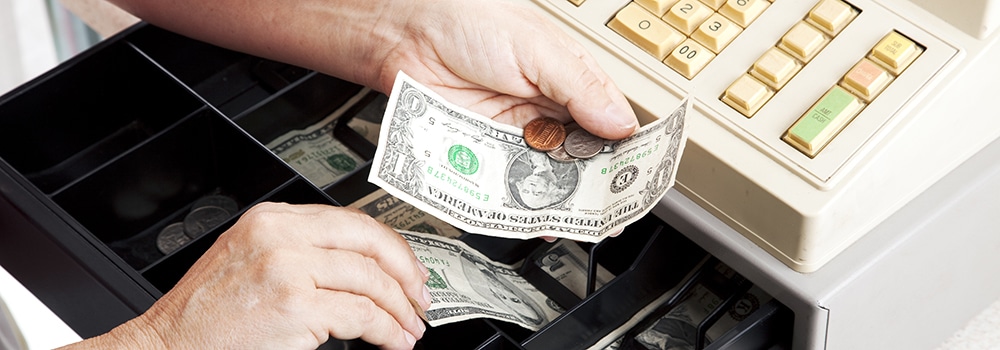Menu
Login
- SOLUTIONS
-
-
FRANCHISEES
-
FRANCHISORS
PARTNER VENDORS
-
-
-
- MARKETPLACE
- RESOURCES
- ABOUT
- SCHEDULE A DEMO
-

Owning a quick service restaurant (QSR) is a big investment (and not just the financial kind). Owning several is an even bigger investment – and no matter the size, it's important to protect that investment. One way to do this is by mastering your cash handling procedures.
Cash handling procedures can seem like a ground-level, nitty-gritty concern, but it's one of the many tools above-store leaders (ASLs) have to protect their investment. When your employees handle cash correctly, it decreases the likelihood of loss, miscounts, and theft.
But with so many steps in the cash handling process, tracking it all can become overwhelming. We can help make it easier. Let’s look at the top cash handling practices that all of your employees should follow.
So what should your cash handling procedures include? Here’s a comprehensive list of steps:
1. Make sure there’s only one manager in the safe during each shift. This will probably be the manager in charge or manager on duty.
2. Verify safe funds at every shift change. The incoming and departing managers should both verify the count, and the restaurant leader and ASL must be notified immediately of any large variances.
3. Make sure the cash tracking form has actual cash counted. Cash amounts entered into the back office system or cash tracking form must reflect the real amount counted, not the “should be” amount.
4. Keep your safe funds properly balanced at all times. This may mean shorting a deposit to make the safe balance or adding to a deposit to make the safe balance. The bottom line is that safe overages and shortages need to be reconciled by the end of the day.
5. Cashiers should always count their cash drawer before accepting it.
6. Schedule cashiers for short shifts or settle their drawer every five hours.
7. Don’t allow multiple hands in cash drawers. Only the assigned cashier should be working the register assigned to them.
8. Cashiers should count (or witness the counting) of their cash drawer at the end of their shift and sign the corresponding paperwork. Scheduling is essential to getting this right since you need to allow managers and cashiers enough time to count their drawers at the beginning and end of their scheduled shifts.
9. Put systems in place to verify $50 and $100 bills. The manager in charge should verify and handle the change for the guest. Counterfeit marking pens should be used for any large or questionable bills. Smart safe bill readers can also be used to detect counterfeit bills, especially for stores with smart safes.
10. Limit the amount of money in the cash drawer. You can do this by using “cash drop boxes” underneath and near each cash register for storing all $20 bills as well as excess $10, $5, and $1 bills. Most importantly, the manager in charge must monitor the cash in the drawer.
11. Keep the keys to the register with the manager. Keys in the cash drawer is a huge red flag that there’s something wrong with your cash handling procedures.
12. Count all cash on camera if possible and keep it secured, in a safe, locked cash drawer, or locked office.
13. Reconcile reported daily deposits with validated deposit slips or Smart safe reports, and make sure they match. If they don’t, then contact a supervisor immediately.
Delaget is the number one resource for QSR data aggregation and understanding. Smarter Wins.
PAR OPS' blog on operational strategies to grow your business faster.
Everything You Need to Know About Hiring & Retaining Teenagers During the 2021 Labor Crisis
Nickels and Dimes: 4 QSR Operational Money-Savers You Likely Haven’t Tried Yet
QSR Loss Prevention: 4 Ways to Prevent and React to Employee Theft